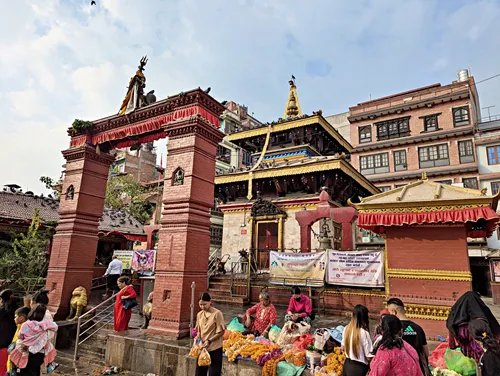Makhan Mahadev Temple (Sano Pashupati): Discover Kathmandu's 'Little Pashupati' Near Durbar Square - Nepal Purple Travel Guide
(map, reviews)
This is Premium Content! To access it, please download our
Backpack and Snorkel Purple Travel GuideNorth of the Kathmandu Durbar Square, behind the tall rectangular red brick arch, lies the Sano Pashupati Temple, also known as the Makhan Mahadev Temple.

Here at Backpack and Snorkel Travel Guides, we typically promote self-guided walking tours.
But we realize that not everybody likes to walk by themselves in a foreign city. So, just in case that you rather go with ab guide: NO PROBLEM! Please see the Viator tours below.
free GuruWalk tours
paid Viator tours
Origin of the name Makhan Mahadev Temple (Sano Pashupati)
The temple carries two names: Sano Pashupati, which means ‘Little Pashupati’. Pashupati (also spelled Pashupatinath) is one of the most revered forms of the Hindu god Shiva. The word Pashupati comes from Sanskrit ‘Pashu’ means ‘living beings’ or ‘animals, and ‘Pati’ means ‘lord’ or ‘protector’. So Pashupati translates to ‘Lord of all living beings’.
Makhan Mahadev, referring to its location in the Makhan area of old Kathmandu and its dedication to Lord Mahadev (Shiva). The name ‘Sano Pashupati’ reflects its spiritual connection to Pashupatinath, the most sacred Shiva temple in Nepal, suggesting this modest shrine shares in the same divine energy, just on a smaller, more intimate scale.
Architectural Style and Setting of Makhan Mahadev Temple (Sano Pashupati)
Built in the traditional pagoda style, the temple is of stone and brick construction, with delicate carvings and a small Shiva lingam housed within.
The temple is easily recognizable through its tall rectangular red brick entrance arch; it symbolizes:
Gateway to the Sacred
The arch functions as a ‘torana’, a ceremonial gateway that marks the transition from the mundane world into a sacred space. In Hindu temple architecture, entering through such a gateway is considered a symbolic purification, preparing the devotee to approach the divine.Framing the Deity
The arch is intentionally aligned with the entrance to the main sanctum, visually framing the Shiva Lingam inside the temple. This architectural framing draws the eye and subtly guides worshippers toward darshan (sacred viewing) of the deity, even from a distance.Protective Threshold
A protective barrier, keeping negative energies or impure forces outside the sacred zone, representing the boundary between the spiritual and physical realms.
The temple also has an approx. 2 – 2.5 ft (70 cm) tall bell in front of the temple and behind the arch. It is used for:
Announcing Your Presence to the Deity
Devotees ring the bell before entering the temple to alert Lord Shiva of their arrival. It’s a way of saying, ‘I am here to worship you’; a respectful spiritual greeting that symbolizes readiness and devotion.Purifying the Mind
The clear, resonant sound of the bell is believed to purify the mind and clear distractions, helping worshippers focus entirely on the divine. In Hindu thought, the ringing sound symbolizes the ‘Om’, the universal vibration and sound of creation.Dispelling Negative Energies
The bell’s sound is also considered to repel evil spirits or negative vibrations, ensuring that the space remains spiritually clean and conducive for prayer.Marking Ritual Moments
During special pujas (rituals), bells are often rung at significant moments, like during aarti (the waving of lamps) or while offering incense and water to the deity. Though this is more common with hand-held bells, the fixed temple bell can also be rung in unison by devotees or priests.
Religious Use and Cultural Role of Makhan Mahadev Temple (Sano Pashupati)
Sano Pashupati is an active place of worship, especially busy on Mondays, which are sacred to Lord Shiva. Locals come to light incense, offer marigold garlands, and pour water or milk over the Shiva lingam, a form of ritual purification and devotion.
Back to your self-guided tour
Author: Rudy at Backpack and Snorkel
Bio: Owner of Backpack and Snorkel Travel Guides. We create in-depth guides to help you plan unforgettable vacations around the world.
Other popular Purple Travel Guides you may be interested in:
Like this Backpack and Snorkel Purple Travel Guide? Pin these for later:





